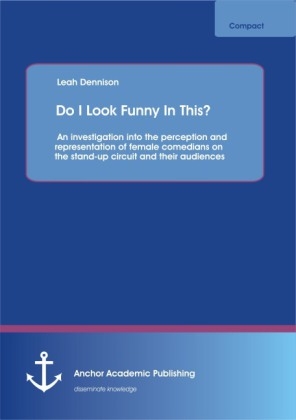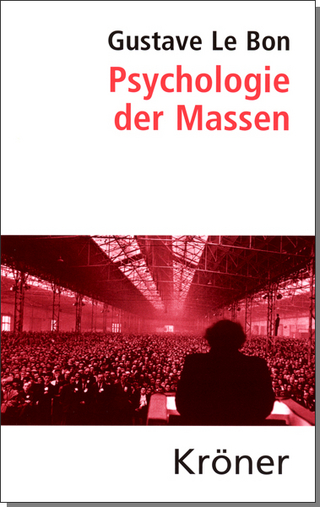
Do I Look Funny In This? An investigation into the perception and representation of female comedians on the stand-up circuit and their audiences
Anchor Academic Publishing (Verlag)
978-3-95489-347-8 (ISBN)
It goes on to give an historical overview of British stand-up comedy, covering the Music Hall/Variety tradition, the Working Men s Club tradition and the Alternative Comedy tradition examining the cultural attitudes of the time alongside these various stages of British comedy and the place women found within them.
Concluding with a case study on Bridget Christie and her success at navigating the patriarchal world of comedy, an investigation of current panel shows figures and their representation of female comics and interview responses from current women stand-ups on the circuit. Illustrating that audiences may no longer perpetuate these long held stereotypes, but instead the industry gatekeepers , the bookers, promoters and producers within the comedy business, are limiting aspiring female comedians from garnering mass exposure.
Leah Dennison studied Scriptwriting for Film and Television at Bournemouth University and went on to undertake a Masters degree in Digital Media at Sussex University. She lives in Brighton and is constantly writing professionally and also personally.
Kapitel 2.1 A History of Women in Comedy:
To analyse the current attitudes towards women in comedy, we must first contextualise the roles women have played within comedic platforms throughout history to realise the social and cultural influences that have aided their gradual rise into the public domain.
The rise of music halls aided women s introduction into the world of professional comedy. The Victoria and Albert Museum (2014) cite that music halls can be traced back to the taverns of 18th century London where men met to eat, carry out business and drink. Performers sang songs whilst the audience enjoyed their meals and by the 1830s taverns had specific rooms devoted to musical clubs. While women were not allowed in the middle-class song and supper rooms, working-class women frequented taverns, accompanying their husbands and often bringing along their children and babies. However, when Mr. Charles Morton (1819-1904) erected the first purpose-built music hall in Lambeth in 1852, he encouraged women into the establishment, introducing Ladies Thursdays, where a gentleman could escort a woman to the hall for the evening. Although gentlemen did not necessarily take up this opportunity - the halls having developed a somewhat vulgar reputation as prostitutes would walk up and down the aisles of the auditorium touting for customers. (Ibid.) Although women were allowed in to watch these male acts, it wasn t until the latter part of the 19th century that women actually began to feature in music hall programmes themselves.
The 19th century saw women work their way, painfully, towards social, political and sexual liberation and these changing times meant humour took on an increasingly important role within their lives. In John Major s book My Old Man: A Personal History of Music Hall (2012) he writes movingly of Jenny Hill (1848-96), a popular British music hall performer of the Victorian era, known as the Queen of the Halls . Major writes: She was more than a great performer she was a feminist trail-blazer, a pro-fessional success, at a time when women could neither vote nor borrow money without a male guarantor; when the professions were closed to them and their only employment choices were low-paid factory or shop-work, or domes-tic service. Jenny Hill not only earned success on her own merits, she re-mained in control of her career: there were no Svengalis for her. She did it her way, and took the knocks.
(2012:132)
Female acts like Jenny Hill were finally given a platform that allowed them to show their talents, although they were confined to singing popular songs and the comic aspects of their material were typically mere segues of patter to lead into the next song. Some women embraced the theatrical notion of cross dressing and created acts impersonating men. These acts subverted and unsettled the dominant ideology of Victorian and Edwardian England. The male impersonators of the music hall distorted the chaste and domesticated expectations of women by adopting a male guise; they challenged the conservative image of stereotyped femininity. Female actors assumed the image of the dominant sex and undermined their values with satirical lyrics and the parodying of male mannerisms.
Perhaps one of the most successful and notable of these male impersonators was Vesta Tilley (1864-1952). In contrast to her 18th and early 19th century predecessors, Tilley did not use masculine attire to heighten her femininity. Earlier cross-dressing acts like Peggy Woffington (1720-1760) and Madame Vestris (1797-1856) had utilised their caricatures to show off their feminine figures within their male costume, thus underlining their sexuality. Tilley and her contemporaries however successfully suppressed their femininity in order to perfect the illusion of being male. Thus powerfully subverting their gender, power roles and identities on stage to audiences of thousands. For the possibility of gender play to arise one has to understand h
| Erscheint lt. Verlag | 27.1.2015 |
|---|---|
| Sprache | englisch |
| Maße | 155 x 220 mm |
| Gewicht | 103 g |
| Themenwelt | Sozialwissenschaften ► Soziologie ► Allgemeine Soziologie |
| Schlagworte | Comedy |
| ISBN-10 | 3-95489-347-9 / 3954893479 |
| ISBN-13 | 978-3-95489-347-8 / 9783954893478 |
| Zustand | Neuware |
| Haben Sie eine Frage zum Produkt? |
aus dem Bereich


